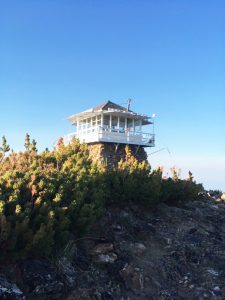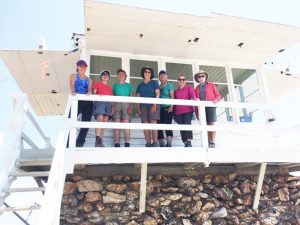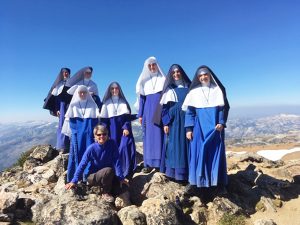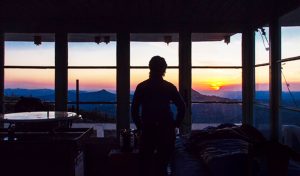
If you look up at St. Mary’s Peak from the valley floor around Stevensville on a clear day you can see a small cube-shaped dot protruding from the ridgeline at the mountain top. What you see is the St. Mary’s Lookout, the perch from which for decades dedicated individuals have scanned the surrounding forests for signs of fire.
The iconic structure is worth a closer look, and though its primary function as a fire tower has been mostly usurped by more modern detection methods, it still stands as a place of historic interest and draws visitors from all over the world.
St. Mary’s Lookout was the eighth fire tower to be listed in the National Historic Lookout Register and the first to be listed by the U.S. Forest Service. The current lookout is actually the second one to be built on the spot. The first, a fifty-foot tall wooden tower built out of timbers, was erected in the early 1930s and had a telephone installed for reporting fires.
According to an article in the Helena Independent published on June 1, 1931, “Telephone crews of the forest service are building a telephone line to the lookout tower on St. Mary’s peak. The new lookout tower on the mountain peak west of Stevensville will be one of the best and highest lookout towers in the district when completed and it is said that the telephone system to it will be completed in a short time.
“For two weeks men have been digging holes and setting poles for the forestry line. It will connect with the main telephone line at the Stevensville bridge and will follow roads and lanes southwest to the foothills and then up the mountain side.” The fire tower itself was constructed in the summer of 1935 and local ranger O. E. York was in charge of the work. But the fifty-foot tall wooden tower was destroyed in a windstorm in 1951.
The next summer a new lookout was constructed according to a different design and the telephone was replaced by radio. The new construction was announced in a Ravalli Republic article in August of 1952:
“The lookout tower atop St. Mary’s peak will be reconstructed to serve as a relay station for forest service frequency modulation radio communication, according to forest service officials in the Stevensville district.
“Originally the tower was to be abandoned since the cab was blown off in 1951 and conditions on the peak are too severe for firewatchers to live in tents.
“The new tower will use a recently designed cab mounted on a 12-foot stone masonry room. Only cement and sand will have to be carried to the peak as the stone needed for the construction is already available. It is hoped to have the job completed in time for use during the 1953 fire season.” The work was completed and in the summer of 1953, lookout Les James enclosed the tower with native rock. The finished work provided secure storage, complete with a door and windows.
The lookout was closed in 1971 as better fire detection methods came into play and was removed from the forest’s fire plan due to chronic poor visibility following storms.
After a couple of decades had passed, however, the Lookout underwent a complete exterior restoration with the aid of a Passport in Time volunteer project and started its second life as the historic tourist destination point that it is today. A new cedar shingle roof was installed in 2008.
One of the tallest peaks in the Bitterroot valley, at 9355 feet, St. Mary’s Peak is remarkably easy to access. The trail to the lookout is a relatively short trek. It is well built and well maintained and the average hiker can make it up and back in around four hours. The reward at the top is one of the most breathtaking views imaginable. Looking west from the tower you are gazing deeply into one of the country’s largest tracts of untrammeled wilderness with a veritable sea of mountain peaks stretching out before you.

The lookout is staffed throughout the summer by volunteers who spend one or two week shifts at a time living in the lookout and greeting visitors who have made the successful climb. The volunteers are provided by the Selway-Bitterroot Frank Church Foundation. Formed in 2005, the organization helps steward the 4 million acre Selway-Bitterroot Frank Church-River of No Return Wilderness, across Idaho and Montana. Volunteers help ensure recreational use by opening trails and maintaining trail connectivity. They also protect the natural conditions of wilderness ecosystems through wilderness and water quality monitoring, campsite obliteration, removal of invasive plants and erosion mitigation. Volunteers can also co-host a Forest Service cabin or lookout, drive shuttles, and pack in supplies for crews on extended trips. The organization is always seeking volunteers for local, community projects.
Volunteers generally staff the lookout from mid-June through mid-September. This year, two of the six volunteers were from Stevensville and the other four from Missoula. Stevensville resident Sheryl Olson put in a two-week-long shift in August at the peak of the season and was impressed by the number of visitors. As of August 28 this year, lookouts counted 1,146 visitors to the site.
Registry tallies at the summit show that 220 of the visitors were residents of the Bitterroot Valley. Another 180 came from somewhere in the Missoula area. The rest of the visitors came from outside of the area, from places like Great Falls, Polson, Bozeman, Simms, Havre, Columbia Falls, Helena, St. Ignatius, Glendive, East Glacier, Hot Springs, Livingston and Butte. Others came from 37 different states with California, Washington and Virginia showing the highest numbers. The rest came from seven different foreign countries including Palestine, Mexico, Spain, United Kingdom, Venezuela, Germany and Hungary.

According to Olson, the trip to the peak is a very special occasion for the visitors. Family reunions and class reunions are held at the lookout. Couples have gotten engaged there, and others have had their ashes scattered. The lookout is also high on the list for Peak Baggers and other hiking enthusiasts. She said one man named Montague celebrates his birthday every year with a walk to the lookout. This year he celebrated his 83rd birthday there. Another time four out of the 18 people at the summit were celebrating their birthdays and none of them were related. Olson said that one of the most surprising and enjoyable groups to visit were the famous “Singing Nuns” who came from Spokane last year for a trek to the peak. She said they even sang a few songs for her on the peak, including “Ave Maria.” She called it “a very special moment.”
Olson said that by attracting such numbers of people from so many different places, the St. Mary’s Lookout has become more than an isolated historic landmark. It has become a valuable economic asset to the little town of Stevensville and the rest of the valley.
The town of Stevensville has long recognized the historic importance of the lookout and the Stevensville Museum has an exhibit that fills an entire room dedicated to the historic structure.

Clark and Helene Lee says
The Mrs. and I were married in the tower 9/7/02. It will always be a sacred site to us.